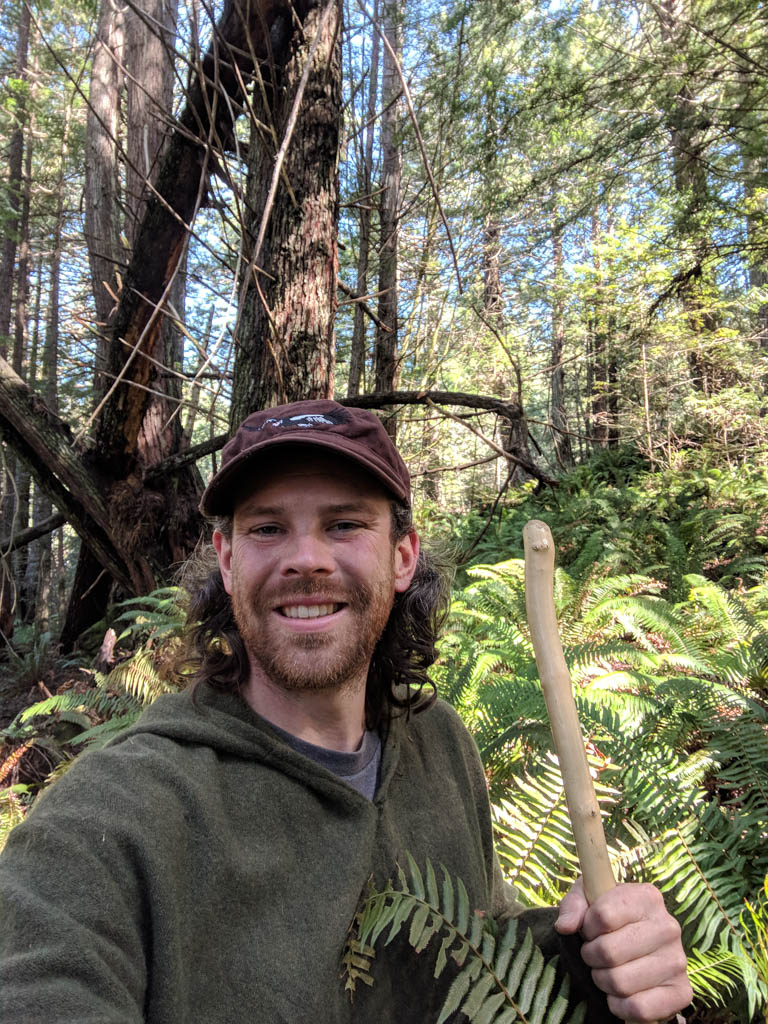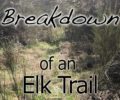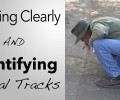Breaking Down an Elk Trail
The following guest post was written by my friend Preston Taylor. Preston is certified as a Senior Tracker and is very passionate about trailing, hunting, and finding wildlife. Click here to send Preston an email.
Here follows a photographic and explanatory guide to trailing: the act of following an animal’s spoor to find that specific creature. Many people are familiar with tracking game in snow, yet the skill can be applied to big game beyond the substrate of snow. Trailing conditions are different for each environment, and you will have to experiment in your area to figure out when the substrate is best. Across the country it seems like rainfall creates favorable trailing substrate, so I focus my trailing practice to coincide with weather events. In this article I will take you through the process of trailing an elk from the beginning, finding a track, to the end, seeing the animal. I assume you already have a location with good substrate, animal activity, and plenty of room to roam.
The day for me begins shortly after sunrise. It is winter here along the coast of northern California, and yesterday the skies dumped over an inch of rain. As I walk up a dirt road I know any tracks I cross that have not been rained on were from last night. The road is a blank slate (figure 1).

Figure 1
The first set of tracks I cross are really old (figure 2); in fact they are two months old. I know this because I remember when I first saw them the day they were fresh. It is clear they have been rained on many times.

Figure 2
After a mile of walking I cross fresh elk tracks (figures 3 & 4). At first I only need to determine that the trail was made after yesterday’s rain so that I know it is worth pursuing. Later I will refine my estimation of the trail’s age. For now I focus on the following attributes: the tracks have not received any rain, the texture of the tracks is different than the texture of the surrounding substrate, the color of the exposed mud is bright and dark (not dulled by wind or sun or rain), the edges of the toes and ridge between the toes are crisp and sharp.

Figure 3
The elk was walking downhill along the road feeding on new plant growth (mostly the fresh shoots of grass). Before I start trailing I make a guess as to the sex of the animal. Looking at a comparison of the front and hind hooves, it is clear that the front hoof is much rounder and wider than the hind hoof, so I assume this is a male (bull) elk. The sun has dried some kicked up dirt around the tracks, so I know the trail is not smoking fresh (figure 4).

Figure 4
Following the bull down the road was easy: I could clearly see every footprint as he meandered along and fed. When he reached a small saddle, the elk turned south off the road and onto a game path (figure 5).

Figure 5
Here we left the easy tracking of wet mud and entered into the diverse substrates of forests and meadows. Seeing tracks along the trail once off the road is like playing a game of connect the dots: you don’t need to see every sign, just enough to keep you on the trail. Some of the spoor will be obvious and other sign will be obscure. Here is an example of an easy to see footprint along the grassy game path (figure 6). The elk was using the game path, so all I needed to do was occasionally confirm that he had no turned off by seeing some sign every 20-50 yards or so.

Figure 6
I continued tracking along the game path like this, sometimes seeing tracks and sometimes seeing sign. Notice the broken branch of a coyote brush (figure 7).

Figure 7
The bright green inner bark confirms it is the fresh trail; under fur and guard hairs cling to the twig. The branch is broken and pointing in the direction the elk was walking. Along the thorny branch of a blackberry bush clings mud from the bull’s leg (figure 8); a slight musky odor of the bull could be smelled on this branch as well.

Figure 8
Flagging and smeared mud are sometimes more obvious than actual tracks. Figure 9 shows a slightly obscure footprint in the grass with some mud splattered on the surrounding leaves.

Figure 9
Figure 10 is an even more subtle print in the humus of conifer needles, moss, and decaying twigs; the track is to the right of my hand in the picture.

Figure 10
Can you spot the track at the bottom of the photo in the patch of sunlight and another footprint in the middle of the picture of figure 11?

Figure 11
The bull continued down this game path for half a mile. In places the path became really thick (figure 12).

Figure 12
But thick brush and fallen logs are no obstacle for a big bull elk (figure 13).

Figure 13
The tight brush made for great flagging sign (figures 14 & 15).

Figure 14

Figure 15
Eventually he popped out onto a creek bottom with an understory of sword fern and salal (figure 16).

Figure 16
The dense carpet of redwood needles under sword fern proved to be a very difficult substrate to see spoor. Every once in a while I found a complete track (figure 17), but often I had to rely on slight bruising of plants and other subtle sign to stay on his trail (figure 18).

Figure 17

Figure 18
This creek flowed to some people’s property, and it looked like the elk was going to walk to their meadow to feed. So I had to leave the track and cut for his trail further ahead. Typically, these bulls would feed down the mountain at night, and with the rising sun walk uphill to bed for the day. We were pretty low on the mountain, so this bull could walk a couple miles uphill before bedding. I maneuvered to the east side of the creek, and staying well out of sight began to parallel the meadow looking for the bull’s track.
If you ever have to leave the trail to pick it back up again, or lose it in a long section of difficult substrate, then you must be clear about the age of the trail you were following. That way you can be confident when crossing older trails while trying to get back on track. I cut a few sets of older elk trails, but never saw his fresh set come up the hill. So I walked up to another older road that I thought the bull might have headed for from the meadow (figure 19).

Figure 19
Walking along this game path there were lots of old tracks (figure 20) that had clearly been rained on.

Figure 20
I continued walking, confident that if the bull came up here I would find his sign. It was possible that he had stayed down by the meadow for the day. My plan was to completely circle the area and either cut his track or confirm that he was still down there. It wasn’t much further along the game path that I found fresh sign of the bull (figures 21 & 22).

Figure 21

Figure 22
Great! I was back on the trail. The bull had come uphill from the meadow and was now walking along the game path. The woods opened up into an older forest, which had been thinned some decades ago. The tracks were easy to see, so I followed alert to the forest creatures. As I approached a thick clump of redwood trees I heard a stick snap on the other side. I froze and a little bit of movement caught my eye. There was the bull elk, standing 15 yards away on the other side of the trees, and looking at me (figure 23).

Figure 23
His tan coast was sleek and shiny. Atop his head sprouted a new growth of antlers. The light breeze coasted crosswind to us, so he could not smell me. He must have heard my footfalls as I approached him in his bed. It is very difficult to sneak up on a bedded animal, especially if you do not know exactly where he is. We watched each other for a few minutes until he turned and walked away downhill.
I walked over and looked at his bed site. It was tucked up against a big redwood trunk. Had I stayed on his tracks I would have walked past him where he could have seen me; he had circled around the clump of trees before bedding. I was grateful for a close encounter with such a secretive forest creature, and I walked home with a smile on my face (figure 24). It had been a good day of tracking.

Figure 24
Trailing an animal like this provides me insight of the secret lives animals live around us day to day. When you walk in their steps, you come to see the world through the eyes of an elk, or bear, or wild hog. Aside from studying and hunting animals, I enjoy trailing for the relationship I develop with the wild critters I encounter. These quiet moments on the mountain start to make up my day to day.
6 Comments
Leave a Reply to mikael behrens Cancel reply
You must be logged in to post a comment.







Thanks for this fascinating post! What is “flagging sign”?
Flagging sign usually refers to a leaf or some vegetation that was brushed by the animal and appears out of place. Often the lighter-colored underside of a leaf will be turned upward and stand out.
Ah! Thanks, now I see the upside-down leaves in figures 14 and 15.
Preston, Thank you for making the effort and taking the time to present your story. I can feel your enthusiasm and love for trailing. Well-presented.
Thanks for sharing.! A great story to read. I haven’t seen many elk so far, but everytime I did, I was impressed by their size! René
Great article. Thanks for taking us along in this Bull Elk’s footfalls.